In the last part we explained how we have designed and constructed a winding device for cables to aid our production team.
The tension is rising, we are ready to print. What will the objects look like? We are curious to find out if our design was correct and whether the parts fit to each other. Is the rolling up performing well?
Let’s inspect.
The first printing trail
We load the 3D model in the Cura software. The model is quite large with an area of 209 mm x 180 mm. The dimensions are such that it fits in the printing area. The fixture and the rotary table are positioned and the Slicer in Cura is started.
This generates the following preview:
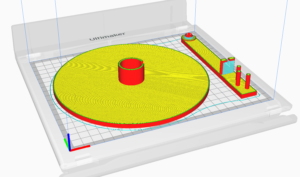
The computation projects an estimated 22 hours for the printing process. We hope that everything runs smoothly over night.
Crank it up.
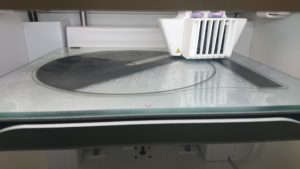
The object grows, layer by layer. Looks good thus far. The following day, it is completed:
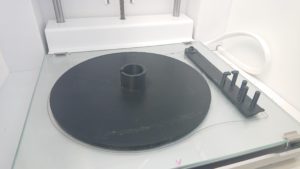
Has much resemblance to what we expected. The underside was detached from the printing bed at some spots, but that shouldn’t mess it up.
Is it functioning?
To start with, we test the pin. It was largely designed intuitively. Click! The rotary table snaps, is being held down on the fixture and is easy to rotate. Cool, it is working as envisaged. Our chest swelling with pride, we proceed to the production process.
Our first trail
This is the moment of truth, revealing if our design is fit for service. The fixture with cable brake and downholder and also the rotary table need to stand the test of practice.
We pick a vice to hold the fixture and then roll up the cable. It fits perfectly into the support:
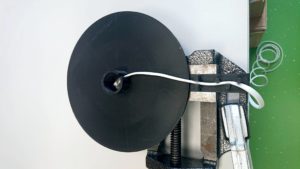
Let’s roll…
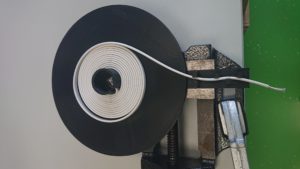
And indeed, it performs well. The cable is kept under tension by the cable brake, allowing a uniform winding on the rotary table.
Only the removal of the cable roll proved difficult. It is rolled up quite tightly around the inner cylinder. This results in significant friction here and the cable is difficult to remove. Some cable rolls opened up in our first trials.
This is where the crank intervenes.
The crank
The crank was already planned in our design. But it needs to be designed so that the removal of the cable roll from the rotary table is easier.
Our approach: the crank serves a localised enlargement of the cylinder, rather than in a plane. Thus, we hood the cylinder of the rotary table with it.
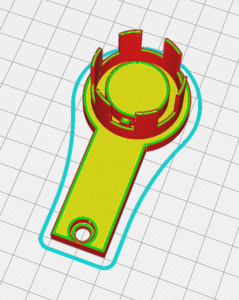
An inner cylinder and a snap-in nose serve as guidance, fitting the rotary table. The outer cylinder forms the uninterrupted contact faces for the cable. Consequently, the friction should be diminished.
A hole in the crank aids the fastening of a rotary knob with a screw.
The crank can be printed quickly. The result is highly satisfactory:
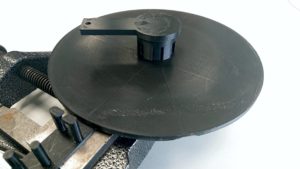
Performance in the production
The first attempts were very positive. But how does it really aid in the production? More than 1000 cables had to be rolled up. Is our design apt for our production step?
In brief: yes, it is.
The setup is functional. After about 200 cables, wear was detected. The snap-in mechanism of the fixture yielded first. Reconsidering, we replaced it with a machine screw.
Thereafter, two of the surrounding grips of the crank broke. The selected material, Tough PLA, proved too brittle. Another attempt with nylon as material resulted in more robustness of the crank.
Summary
All things considered, the winding device was a highly intriguing project. The design of such an aid was a novelty for us. The result served the purpose and has considerably eased work in the production. This was our intention.
We are lured into more. In the future, we definitely intend to print some of our auxiliary devices. More experience in design and material selection is required though.
This series will continue. In the next part we demonstrate the usage of 3D printing in product development and how to skip design cycles.


